Intervention’s project for the student with cerebral paralysis
DOI:
https://doi.org/10.30827/retosxxi.1.2017.24025Keywords:
rebral Paralysis, pre-schoolers, Communicative problems, Intervention’s projectAbstract
This end of degree project will be carried out an Intervention Program for students with Cerebral Paralysis for children addressing communication and development. We will work with a student of Pre-school Education, a specific school from province of Granada. A globalizing approach will be used to bring the school closer to what it has to learn in a meaningful and integrated way. As an essential instrument, various combined and structured learning methods have been used to provide the student with the communicative tools necessary to succeed in any situation socio-communicative. From the educational point of view, I consider it vital to provide tools, methods and resources to the student to promote emission of bi-syllable, bilabial words, phonemes and matched vowels. Likewise, with this program it is essential that the student can expresses their emotions, desires and as mentioned above, unfolds in the social, family and academic context to be understood easily. After the implementation of the Intervention Program, there was a remarkable evolution in the school thanks to the coordination and participation of this school with the family. Nevertheless, due to the limitations of the student, it should continue to promote such learning in the child to improve the desired oral and written expression.Downloads
References
Adelson, K. (2016). Drunker Sailor, intrumental Fiddle Sea Shanty. Recuperado de: https://www.youtube.com/watch?v=IFSqjyigczU
Bascarán, M. (1999). Niños y niñas con parálisis cerebral. Descripción, acción educativa e
inserción social (Cáp.6). Madrid: Narcea
Castaño, L. (2015). La observación en Educación Infantil. Recuperado de: https://es.slideshare.net/luciaCjimenez/tema-2-la-observacin-en-educacin-infantil-47559893?next_slideshow=1
Colman, A. (2017). Los sistemas aumentativos y alternativos de comunicación. Recuperado de
García, A. (1999). Niñas y niños con Parálisis Cerebral. Madrid, España: Narcea.
Madrigal, A. (2007a). Familias ante la Parálisis Cerebral. Recuperado de scielo.isciii.es/scielo.php?pid=S1132-05592007000100005&script=sci_arttext&tlng=en
Madrigal, A. (2007b). La Parálisis Cerebral. Recuperado de http://sid.usal.es/idocs/F8/FDO8993/pa
ralisis_cerebral.pdf
Martín, J. (2011). Parálisis Cerebral y contexto escolar. Madrid: Fundamentos psicopedagógicos
Pozas, J. (2014). Proyecto didáctico para alumnos con PC. Valladolid: Universidad de Valladolid.
Recuperado de http://uvadoc.uva.es/bitstream/10324/12980/1/TFG-B.679.pdf.
Ramos, O. (2015). Propuesta de intervención con un alumno con parálisis cerebral. Una mirada inclusiva. Valladolid, España: Universidad de Valladolid. Recuperado de http://uvadoc.uva.es/bitstream/10324/12892/1/TFG-0%20460.pdf
Robaina, G. R., Riesgo, S. y Robaina, M. S. (2007). Definición y clasificación de la parálisis cerebral:
¿un problema resuelto? Revista Neurol, 45, 110-117.
Rodríguez, A. (2015). Un currículo para múltiples adaptaciones. Madrid: EOS.
Rosen, M. G. y Dickinson, J. C. (1992). The incidence of cerebral palsy. American Journal of Obstetrics and Gynecology, 167, 417-23. DOI: https://doi.org/10.1016/S0002-9378(11)91422-7
Rosenbaum, P., Paneth, N., Levinton, A., Goldstain, M. y Bax, M. (2007). A report: the definition and
classification of cerebral palsy. Developmental Medicine & Child Neurology, 49, 8-14.
Sánchez, J. y Llorca, M. (2004). Atención Educativa al alumnado con Parálisis Cerebral. Málaga: Aljibe.
Xhardez (1992). Tratamiento fisioterápico en la parálisis cerebral dentro del ámbito educativo.
Zaragoza: Asociación Española de Fisioterapeutas.
Published
How to Cite
Issue
Section
License
Copyright (c) 2017 The Educational Journal of Works Aimed at the XXI century (XXI CHALLENGES)

This work is licensed under a Creative Commons Attribution-NonCommercial-ShareAlike 4.0 International License.












